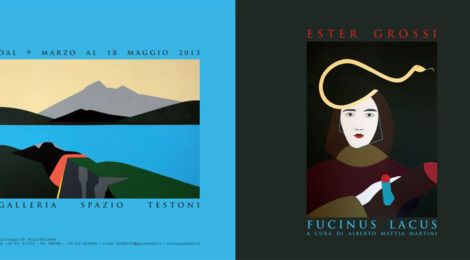
Ester Grossi – Lacus Fucinus
By Alberto Mattia Martini
9 March – 18 May 2013
Extended until 29 June 2013
Opening Saturday 9 March 2013 from 18.30 all 22.00
Suetonius (21, 1214) wrote: "For Julius Caesar - the Great Father of ancient Rome - the draining of Lake Fucino represented the most prestigious project and extraordinary for the adornment of Rome, for the beauty and richness of the Empire ".
The project FUCINUS LACUS of Ester Grossi, which premiered at the Museo della Permanente in Milan in October 2012 on the occasion of 13Prize Cairo, is developed and extended to the eponymous solo exhibition curated by Ester Grossi Alberto Mattia Martini, to be held from 9 March 18 May 2013 SPACE TESTONI at the gallery in Via D'Azeglio 50 in Bologna with opening Saturday 9 March 2013 pm 18,30 at 22,00.
This project comes from the artist's personal desire to return to the place where she was born and where he no longer lives for many years.
"... As often happens, the desire to know more about the history, emerges with time and distance. As a child I had the feeling of living in an area of Italy, Marsica (a sub-region of Abruzzo), only in terms of natural, archaeological and its technological development. My view of the history marsicana has always been romanticized and fantastic, and despite the historical research of which I made use for the development of this project, I try to keep it in part. The desire is to finish the tour exhibition, in a final stage in the place of origin, then in Marsica ... "_Ester Grossi
Watch the teaser video of Lacus FUCINUS:
English press release:
http://www.ldwt.net/2013/02/fucinus-lacus-new-works-by-ester-grossi/
FUCINUS LACUS
Critical text by Alberto Mattia Martini
Fucino! Who is this?? Beginning of this reflection about the latest work by Ester Grossi in a deliberately ironic and with a clear reference Manzoni, because I have to admit that I learned of the territory of Fucino, Once you see the project presented by Esther in the latest edition of the 13th Cairo Prize. However, after observing the work of Esther and after I compared her, has resulted in me a desire to understand and to better understand this fascinating place for its unusual and remote history, for the incredible vicissitudes and transformations that the protagonist over the centuries.
Has been perhaps my curiosity, that I have always “pursued” and without which it would be impossible to devote himself to art, or the tremendous pleasure mixed with anger, that every time I am assailed by the neck like a bite of a rabid dog, when my eyes discover the beauty of my beloved homeland. Are you wondering why this ambivalence of feelings, opposites of each other. The answer is very simple and perhaps obvious, but unfortunately terribly real: the inability and indifference of most of our political institutions and then, with the area and consequently the artistic and architectural heritage in which we live. In this period of election campaign, with great anger and sadness, my good ear has perceived once, just be good for maybe a couple, the word: culture, territory, art and tourism. I find it terrifying!
Excuse my digression, but I also needed to better understand the artistic sensibilities of Ester Grossi and then to have the means to evaluate the research and development by the artist Abruzzo.
It all started a few million years ago; then, in what is the current plateau Fucino, moved its transparent waters karst lake Fucino.
A place apparently magical and extraordinary beauty, so as to be well described by Virgil in the Aeneid, exactly in Book VII to the 759: ” Te nemus Angitiae, vitreous Fucinus you unda, taining liquid flevere lacus”.
His name, from ancient evidence seems to have been: lake Forcone and subsequently Celano, while the term Fucino should arrive from algae that, in very specific periods of the season spread of the waters of Lake Vermilion, making them appear as a breeding.
The reference to Angizia that Virgil declaims, refers to the forest that stretched near the same lake, named after the gods Angitiae, worshiped by the inhabitants of the territory and associated with the cult of snakes, revered as a healer, especially their bites of asps.
A territory as it is easily identifiable, fascinating, magic, intriguing, as can be seen in the texts have survived, of extraordinary beauty, so much so that even the holiday destination of the ancient Romans.
Area certainly unusual if not unique, could not leave indifferent Ester Grossi, original of these places and that motivates the artist herself with these words: “As is often, the desire to know more about the history, emerges with time and distance”.
The famous homesick, very real and exciting, that takes each of us when we are away from our hometown, but above all the desire to investigate and traces, discover and then understand our origins and those of a place unknown to many.
Here comes from here as the project Lacus Fucinus, in an attempt by the artist marsicana to deal with the historical past and the various environmental changes of this area, a unique from the point of view of natural, archaeological and its technological development.
Begins to take shape the historical investigation, anthropological and geographical by Ester Grossi, that detects and deals with his analysis with respect to three key moments in life and change occurring and have occurred in these places: the presence of the lake, the third largest in Italy, transformation aimed primarily agricultural plains and finally the creation of the Space Center “Piero Fanti”. Three cycles, or rather three age, and then three different elements: water, land and air.
The artist deliberately set Abruzzo directing his inquiry as we have said on several fronts such as scientific and historical, referring to sources and documentation, However, giving ample space to the most creative and imaginative and then to a personal interpretation of reality.
The first aspect concerns the presence of water, of the lake on one hand returned to the site a valuable and unusual charm, the other because of the continuous changes in the level and extent, overflowed very frequently, flooding the space and thus causing irreparable damage to the population, time to be established between people and this immense expanse of water a love / hate relationship.
From here takes away the desire to drain the lake, seeing the first attempts in Roman times: first under Caesar and then with Claudio, that can create a culvert approximately 5 Km to ensure that the water flow into the river Liri. A partial draining in which they are used many men, tremendous effort and requires eleven years of work. Unfortunately, their efforts prove vain and in medieval times the Fucino again the undisputed master of the Marsi. Spend several centuries, when in 1855 Alessandro Torlonia, became the sole owner of the land, starts the reclamation and total drainage, coming to fruition in 1878.
The Fucino is so ready for a new life, which no longer sees the protagonist in the water for better or worse, but the solidity and prosperity of the earth.
The first step that Ester Grossi does is to document and interpret this unusual and important step, that not only modifies the territory from the point of view of its geological, but also structural space, which sees the inhabitants confront the partition of the land and then a radical change that directly involves the everyday life and the existence of man, that a fisherman must reinvent farmer.
Where to start? The argument is clearly very large and complex.
Esther decides to inoltrasi developing its iconographic research and inverting ranging from various illustrations made from English Edward Lear half of the'' 800, the etchings of Giovanni Battista Piranesi, the rare daguerreotypes found down to us, i Disegni in Jules Gourdault, the papers of the historian Raphael Fabretti, until lithographs placed in support of the great nineteenth-century atlas Brisse & Rotrou.
A vision so that the evidence from, of course not entirely true as instead can be a photograph, but also leave room for interpretation and that right shall cooperate with the vision that subjective Ester Grossi wanted to return and deliver to the user, as for example in the work Posing.
The way it was before and as it is now, stimulates our curiosity, the desire to know how was the Fucino before that we can define: a metamorphosis morphological and landscape.
Ester with l'opera Lucus Angitiae immerses us in this space, between colors in flat backgrounds, I would say almost willfully and markedly present and continuous within their uniformity while creating a sort of “scattering”, interruptions net, marked, that on their own to live their own life, but united, wrapped, intersected and coordinates “fit” perfectly with each other. They live within the canvas different visual planes, levels and moods that, converge in unison giving life to the work itself.
Even in Clear, fresh and sweet waters this feeling prevails that takes us through a place of time absent, where it dominates the dreamlike atmosphere of a moment frozen in eternal waiting. In these works strangely there no human presence or not another, if not a predominant natural force, although the figure of the man is a constant reference frame and a unique point in the search for Ester Grossi.
Man makes his return to the stage again in the diptych Lacus Fucinus, in which some men observed and compared with respect to an archaeological discovered on the territory: a skull that leads us inevitably to the story but also to death. In the distance is one of the countries that stood and still stand in Fucino, while the center still dominates the presence lake. Near the Iris the Iris Marsica, a floral endemism of this area, shows a female presence that “cradle” his arms a block of wood. The snake next to her brings us back to the figure of Angiza, that I mentioned above and Ester Grossi represented in contemporary. Interpretation that recalls the film, not only a passion for Esther, but a fundamental part of his artistic training. The “Mrs. Strain” is a clear reference to the famous television series of the early 90s: The Twin Peaks. Mrs. Strain, as well as the divinity of Angizia, lives an intense relationship and connection with the forest; the wood and then the strain be over for Lady Yule transposition of the husband died in a fire in the woods, becomes, as well as for the divinity marsicana, sacral element, source of inspiration and magic, that allows even predicts the future. The spirit and the language of both narrative content of the work of Ester Grossi, recall the atmosphere created by David Lynch, regista the TV serial: surrealism that pervades the environment and the lives of the protagonists, uneasiness and anxiety that surround the thoughts, a strong feeling of alienation that leads us by the hand into another world, in the thin line between real and supernatural, all muffled and attenuated with the bittersweet taste of the grotesque and irony.
The transformation of the place in which we are dealing, As often happens when man intervenes in nature by imposing their thoughts and wishes, has drastically changed the entire area. While the reclamation has allowed a retraining agrarian, industrial development and the rise of rural centers, other upset the original conformation, imposing a constant presence and impressive. This “humanization” and “civilization” resulted in a substantial change in climate and inevitable changes of vegetation and fauna.
A news a few days ago appeared in the media about the problem of endangered bear Marsicano, now reduced to approximately 40-50 specimens.
The theme of the drama and I think every time there is a story like this, has not spared even more so Ester Grossi, that work Marsicano brown bear, emphasizes the extraordinary beauty and the indispensable presence of nature, too often at odds with the disharmony and monstrosity of man, understood as pure selfishness and indifference dramatic.
The artist, referring to the proposed aerial view from Google Earth and to make sure that the user can visually understand the current territorial structure Fucino, presents an installation of monochrome canvases, some woven and synonymous with the actual plot of the site and the subdivision of land, of different crops, and thus appear as a vast network geometry once again the fruit of human will.
The next step now is to tackle “the advent” technology in Fucino. An unusual presence in these places, even more anomalous if to settle in the territory comes a center telespaziale.
We are in the 1961 and this area was chosen as the site for the innovative and futuristic center Piero Fanti, a place unique in the industry being the largest satellite in the world with approximately ninety satellite dishes active. Ester Grossi impossible to resist the curiosity and the desire to impress his iconographic research with the middle telespaziale. A place that can not leave indifferent, especially when viewed from, where the mink than the earth brings us back to a futuristic, futuristic space station somewhere in the universe. Here, too, it does not betray the expectations Ester, it herself, In his own art and his ideal language; moving research from real images, it reinterprets the perception, stressing certain aspects, pointing out that technological man often takes possession of nature, as if it were a “what” of its membership, on which he is entitled and empowered to determine the destination, the future and therefore life.
Significant works in which the artist portrays an employee of centrospaziale while he is working on some computers of the 80s; Here, however, human activity and paradoxically so surreal takes place outside, in direct contact with the nature, as if to emphasize the invasion and aggression human.
The illustration in hand with irony and imagination grow so much in the work Rush. Sudden outbreak impetus, to allow a satellite to take a flight to space, despite the center Piero Fanti is not prepared for this purpose.
Ester Grossi takes ultimately lead not with the memory, but in this case with the reality and fantasy, the opening day of the center Piero Fanti. Posing between heaven and earth, portrays some employees placed in line and waiting for the shooting that witnesses the presence; in this work, as well as Visiting the Fucino Space Centre, which is clearly a reference to Aldo Moro, the then Prime Minister on a visit to those places, clearly the mix of elements and references to which the expressive language of Ester Grossi refers. In these paintings the cinema becomes the protagonist, specifically the '50s America Hollywood, through pop-culture, the graphical representation, that overflows comic idiom while maintaining a solid narrative point, in which the artist is able “drag”, making land in a timeless dimension where the emotional involvement boldly confronts the alienation and indifference.


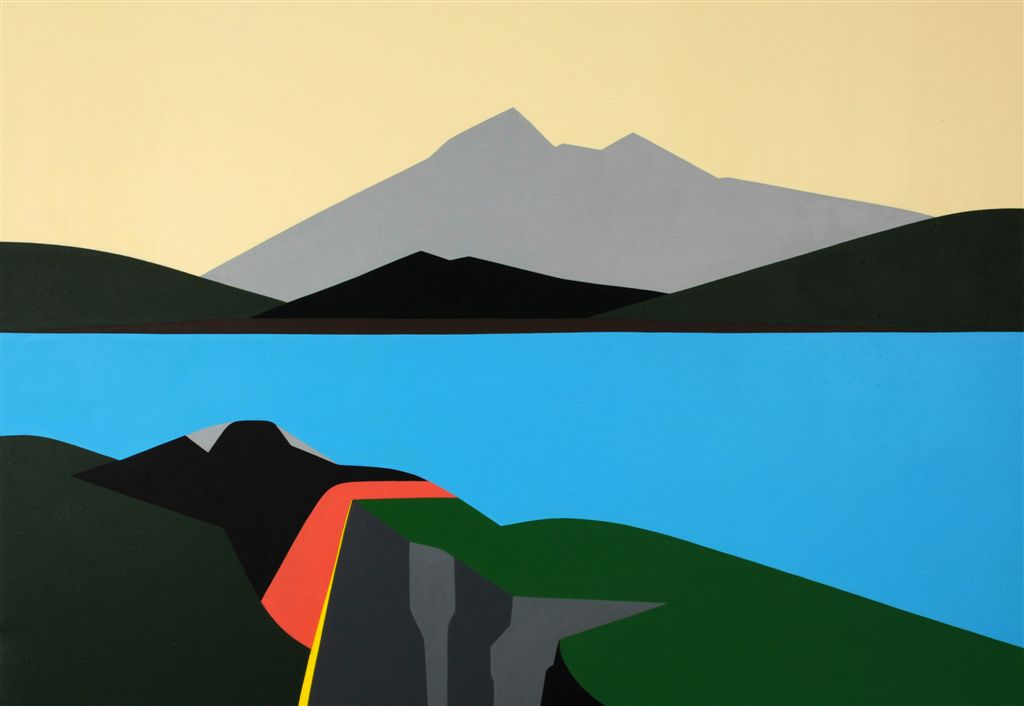
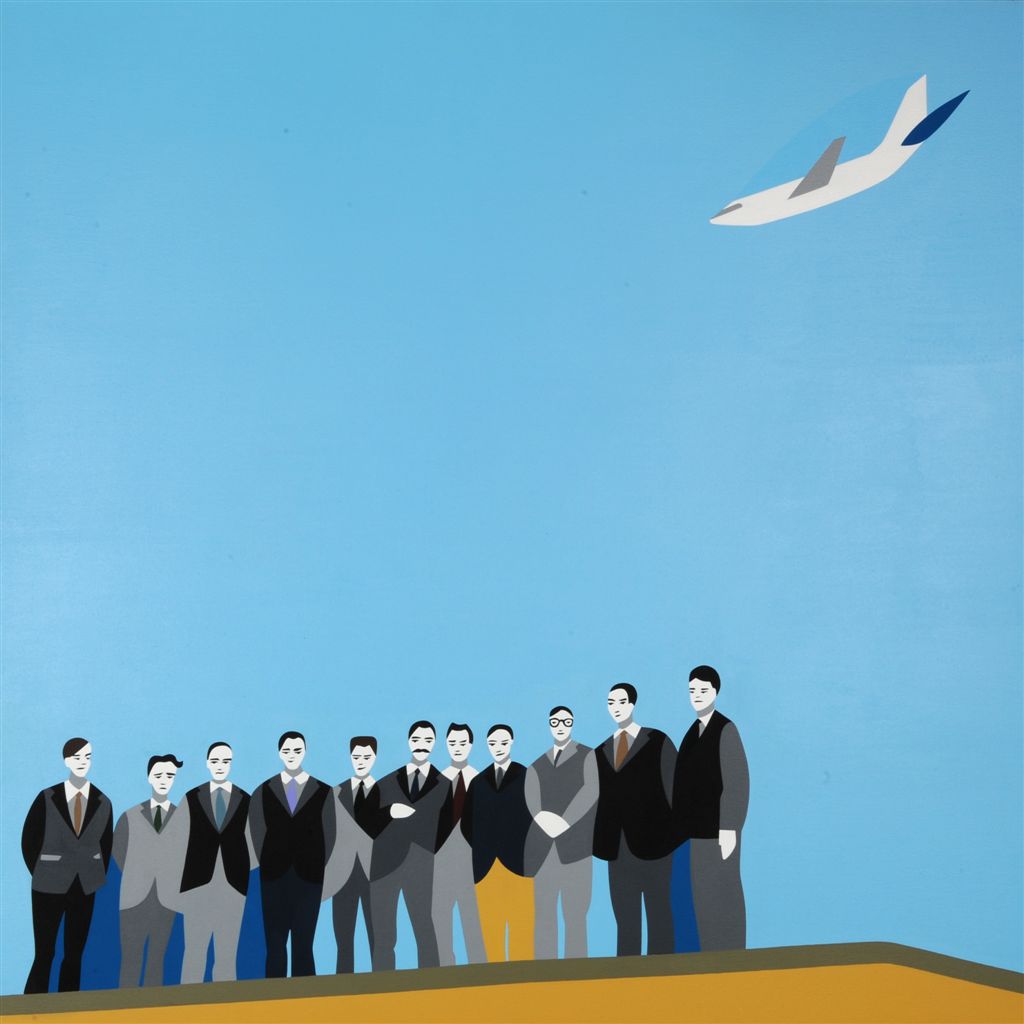

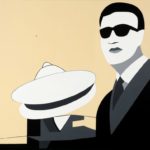

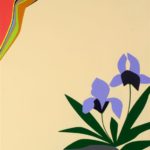
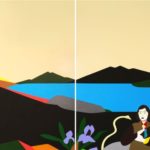

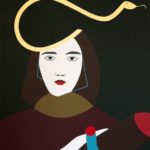




















[…] project "From Fucinus Lacus in Google Earth" recounts the evolution of the landscape and the changes that have affected over the centuries […]